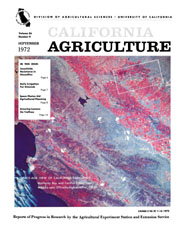


University of California
California Agriculture
|
|||
|
|||

Cover:
Space-age view of California farmland - Monterey Bay and Central Valley from NASA's new 570-mile-high satellite, ERTS-1.
September 1972
Volume 26, Number 9 |
|||
|
University of California, 1301 S. 46th St., Bldg. 478 Richmond, CA
|